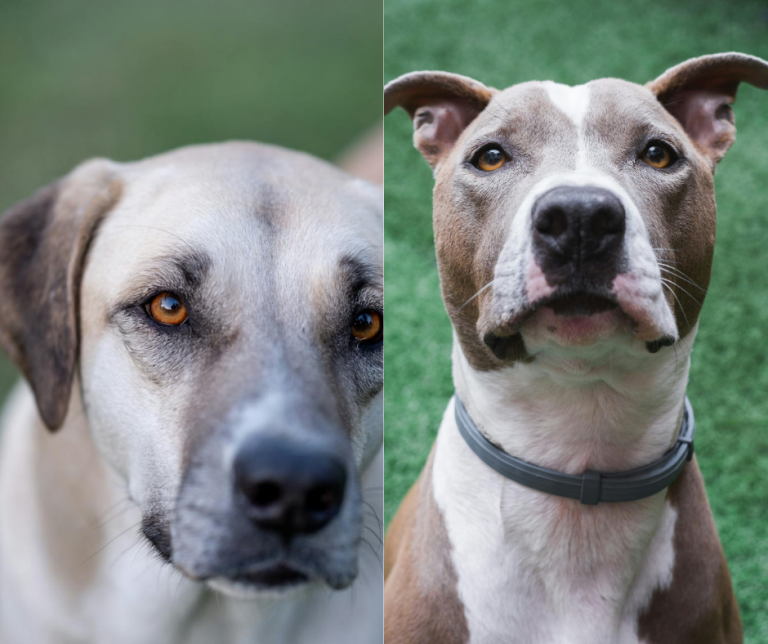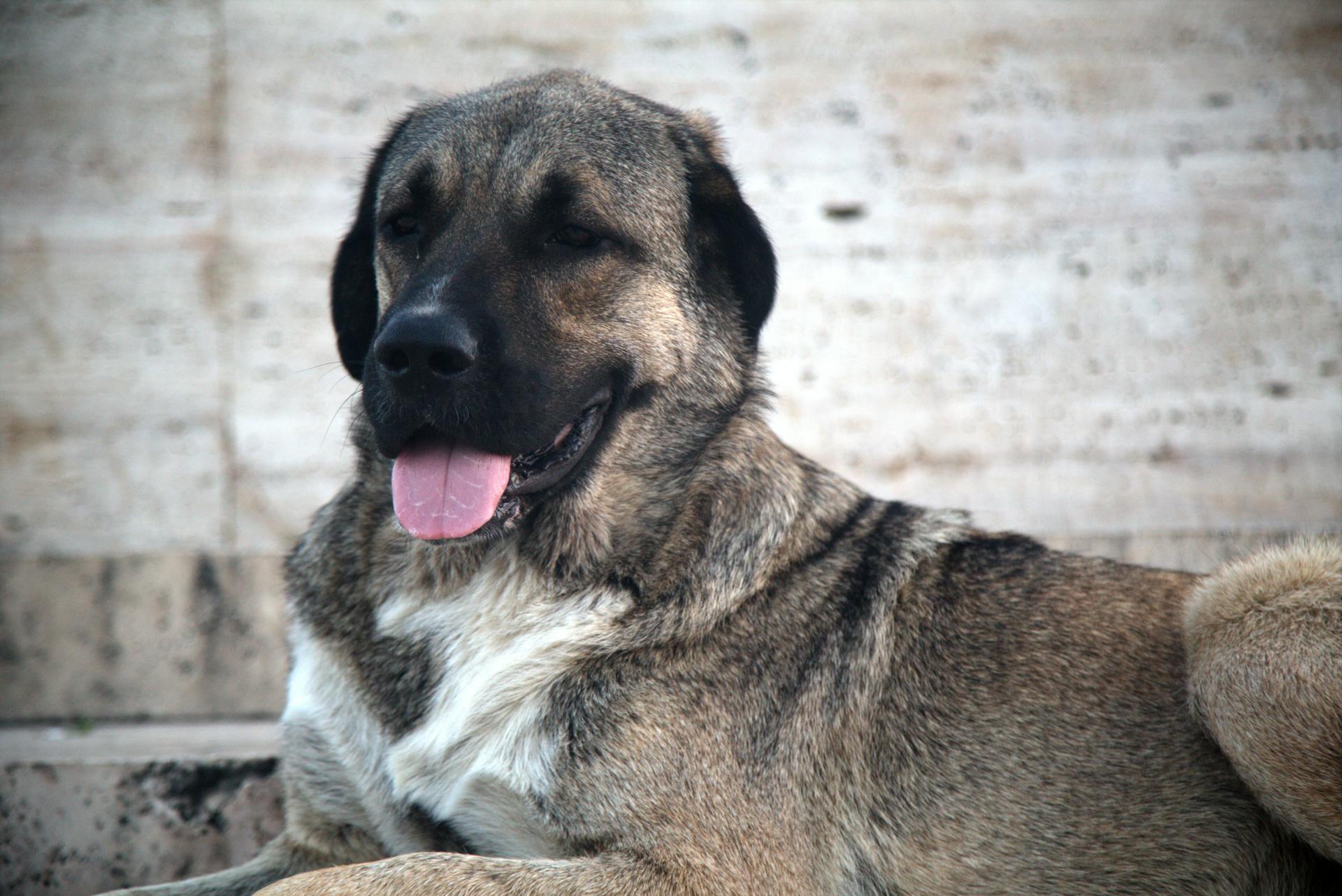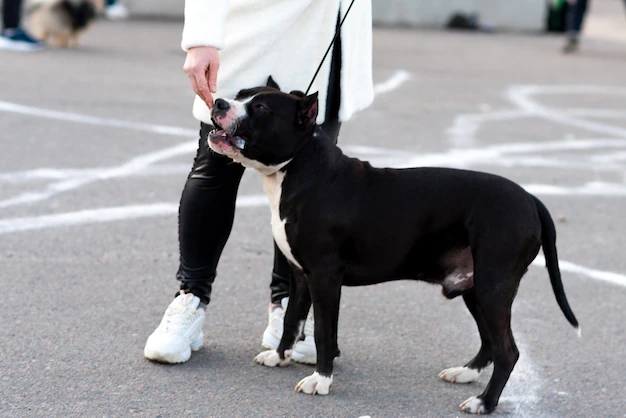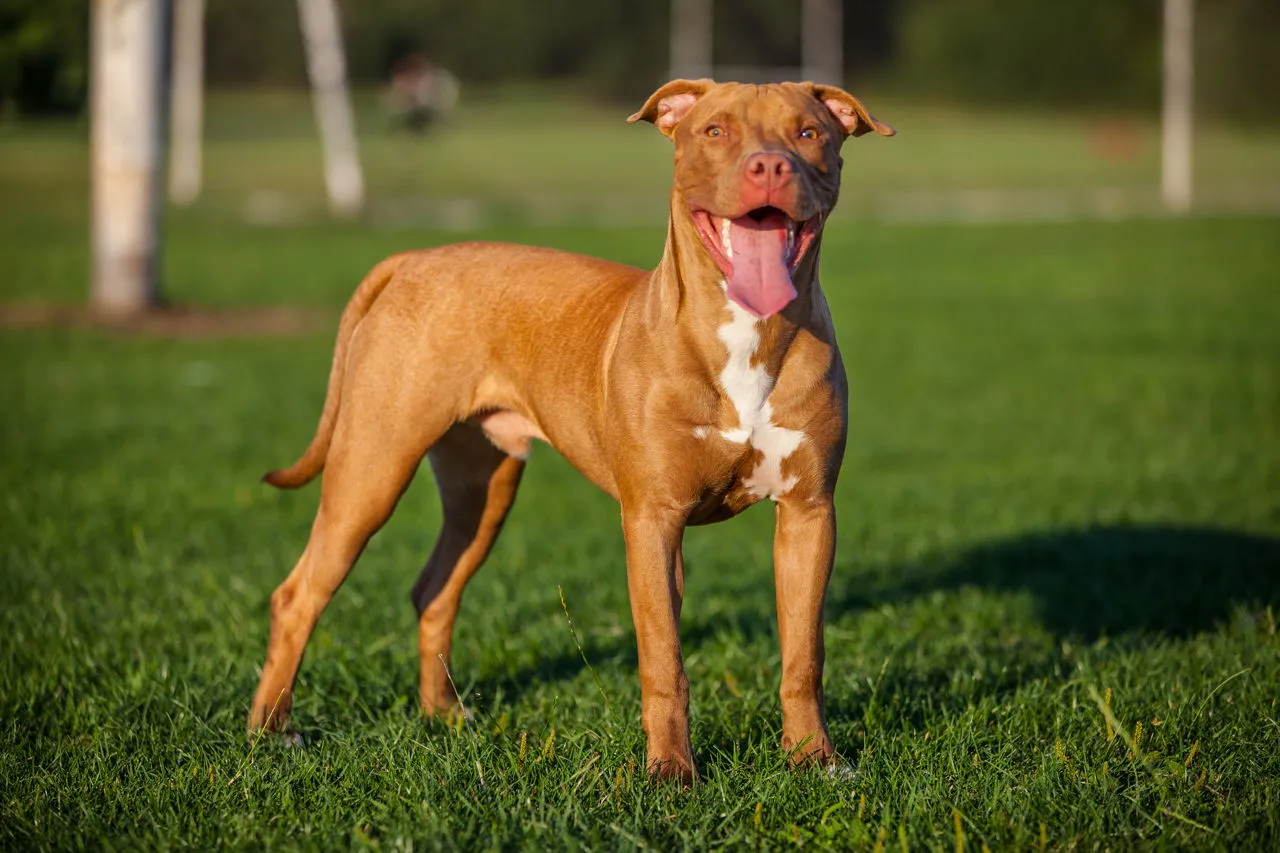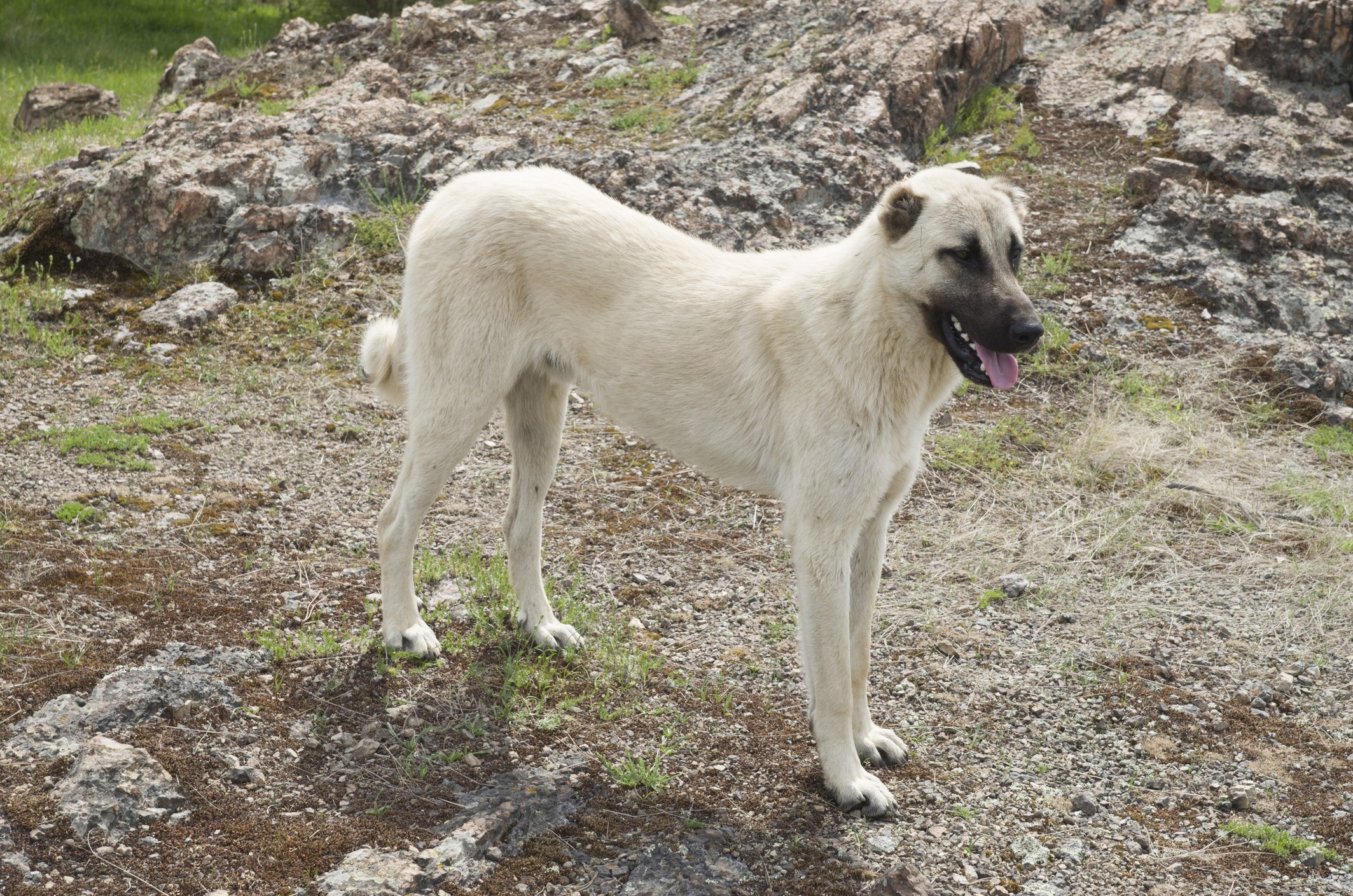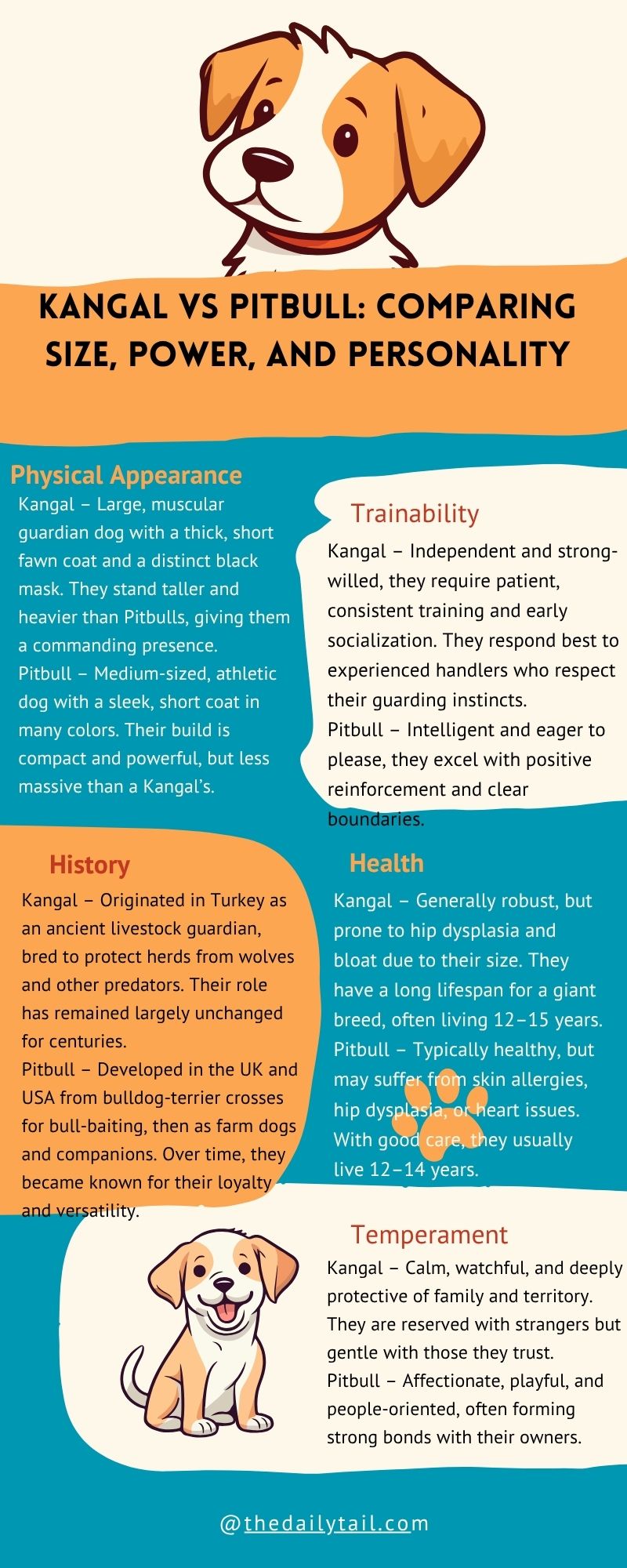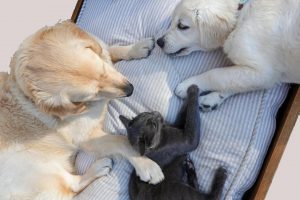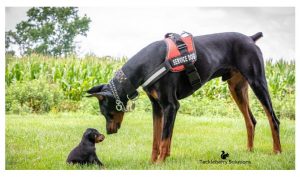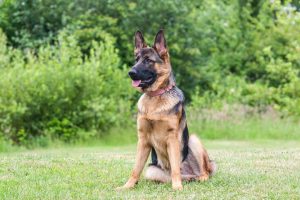The comparison between Kangal vs Pitbull often arises due to their reputations for strength and tenacity. Both breeds have unique traits shaped by different purposes: the Kangal is a large Turkish livestock guardian known for size and bite force, while the Pitbull is a muscular, agile dog bred for versatility. Their differences in build and instinct make a direct comparison intriguing but complex.
When it comes to raw power and bite force, the Kangal significantly outmatches the American Pit bull terrier, boasting nearly double the bite strength and a larger, more robust physique. This advantage often means the Kangal has the upper hand in physical confrontations. However, the Pitbull is known for agility, endurance, and an intense drive that cannot be overlooked.
Understanding how these breeds differ in temperament, training, and natural abilities offers more insight than just physical stats. Exploring these aspects helps clarify why professionals generally consider the Kangal stronger, but also why the Pitbull is respected in its own right.
Kangal vs Pitbull: Key Differences
The Kangal and Pitbull differ greatly in size, bite force, and purpose. Their temperaments are shaped by the roles they were bred for, which impacts behavior and training needs. Their origins also provide insight into their physical and character traits.
Physical Appearance
The Kangal is a large, powerful breed, with adult males standing around 28 to 30 inches tall and weighing between 110 to 145 pounds. It has a muscular build, broad head, and thick neck. The coat is short and dense, usually sand or fawn-colored with a black mask.
The Pitbull is smaller and lighter. Males typically stand 17 to 21 inches tall and weigh between 30 to 60 pounds. Pitbulls have a compact, muscular frame with a shorter snout. Their coats come in a variety of colors and are smooth and short.
One notable difference is bite force: the Kangal has the strongest bite of any dog breed, exceeding 700 PSI. In contrast, the Pitbull’s bite force ranges from 230 to 250 PSI.
Temperament
Kangals are known for their calm, protective nature. Bred as livestock guardian dogs, they are naturally cautious around strangers but gentle and devoted to family and flock. They require consistent training and socialization to manage their guarding instincts.
Pitbulls are energetic, loyal, and affectionate dogs. They were originally bred for bull-baiting and later as companion animals, which contributes to their strong prey drive and tenacity. Proper training and socialization are essential to ensure they behave well.
Both breeds respond well to positive reinforcement. The Kangal’s temperament suits a more reserved, watchful guardian role, while the Pitbull is often more outgoing and playful.
History and Origin
The Kangal originates from Turkey, specifically the Sivas region. It was developed as a livestock guardian, tasked with protecting sheep from predators like wolves. Its instincts and physical strength reflect this protective lineage.
The Pitbull descends from the United States and the UK. It evolved from bulldogs and terriers bred for bull-baiting and later as family dogs and working animals. Its history combines tenacity, strength, and companion qualities.
Their histories influence their behavior and use today: Kangals are primarily guardian dogs, while Pitbulls often serve as companions, sporting dogs, or working breeds.
Breed Overview: Kangal
The Kangal is a distinct Turkish breed known for its impressive strength, protective nature, and working ability. It combines physical power with calm intelligence and a strong loyalty to its environment.
Size and Build
The Kangal is a large, muscular dog, with adult males typically standing 28 to 32 inches tall at the shoulder. They weigh between 110 and 145 pounds, making them one of the heaviest guardian breeds. Their build is robust but agile, with a broad head and strong muzzle designed for powerful bites. Their coat is short and dense, usually tan with a black mask, offering protection in various weather conditions. This breed’s physical prowess is highlighted by its bite force, which averages around 743 PSI, far stronger than many other breeds.
Typical Behavior
Kangals are known for their calm yet alert demeanor. They are naturally protective without being unnecessarily aggressive. This breed shows strong loyalty and intelligence, which allows it to assess threats and respond accordingly rather than react impulsively. Kangals tend to be reserved with strangers but affectionate with their family. They are independent thinkers trained primarily to protect livestock, so they can operate effectively with minimal guidance but require consistent socialization to ensure balanced behavior.
Common Uses
Originally bred to protect livestock, Kangals excel as guarding dogs against predators like wolves and bears. Their strength and protective instincts make them effective in rural and farm settings. They are less common as household pets due to their size and guarding tendencies but are valued in environments demanding serious protection. Kangals also participate in roles requiring strong bite force and physical endurance, such as security and sometimes search and rescue, although their primary skill remains livestock protection.
Breed Overview: Pitbull
The Pitbull is recognized for its muscular build, agility, and strong-willed nature. It exhibits a balance of strength and speed, paired with a loyal temperament. Its roles range from companionship to working dog tasks, reflecting its adaptability.
Physical Attributes
The American Pitbull Terrier typically stands 17 to 21 inches tall and weighs between 30 to 65 pounds. It has a compact, muscular body with a broad chest and strong jaw. Its coat is short, smooth, and comes in various colors including brindle, black, and white.
The breed’s agility and strength contribute to its ability to perform physically demanding tasks. It maintains a moderate bite force relative to larger breeds but compensates with tenacity and stamina.
Personality Traits
Pitbulls are known for their loyalty and affectionate nature toward family members. They are intelligent, eager to please, and highly trainable when socialized properly from an early age.
Despite a reputation for aggression, they tend to be friendly and social with proper training. The breed requires consistent exercise and mental stimulation to prevent boredom and destructive behavior.
Roles and Capabilities
Originally bred for farm work and as hunting companions, Pitbulls now serve various roles including therapy dogs, search and rescue, and obedience competitors. Their high energy and agility make them effective in sports like agility and weight pulling.
Their protective instincts are strong without excessive aggression, making them reliable watchdogs. Their ability to bond deeply with owners supports roles in therapy and assistance work.
Strength and Power Comparison
The Kangal and Pitbull differ significantly in raw physical power. Their strengths are measured through bite force and muscular composition, which highlight the specialized purposes each breed was developed for.
Bite Force
The Kangal possesses an exceptionally strong bite force, measured at approximately 743 PSI (pounds per square inch). This figure is among the highest recorded in domestic dogs and reflects the breed’s role as a livestock guardian, designed to deter large predators.
In contrast, the Pitbull bite force ranges between 240 and 330 PSI. While still powerful, it is significantly lower than the Kangal’s. The Pitbull was bred for agility and tenacity rather than raw biting strength.
This disparity means the Kangal can apply more pressure when biting, which contributes to its effectiveness in protection roles. The difference in bite force is critical when comparing their capabilities in physical confrontations or safeguarding livestock.
Muscular Structure
The Kangal is a large, heavily muscled dog with a sturdy frame adapted for strength and endurance. It typically weighs between 90 to 145 pounds, with powerful limbs built for controlling large animals and sustaining long periods of activity.
The Pitbull is smaller, weighing between 30 to 85 pounds, but is extremely agile and muscular for its size. Its body is compact with well-developed muscles that provide quick bursts of speed and significant stamina.
While the Pitbull emphasizes agility and explosive power, the Kangal’s muscularity is more focused on sustained strength and stability. This structural difference aligns with their distinct working roles: the Kangal as a guardian and the Pitbull as a versatile companion with protective instincts.
Trainability and Intelligence
The Kangal and Pitbull differ significantly in how they learn and respond to training. Both breeds show intelligence but vary in their willingness to comply with commands. Their natural instincts and temperaments heavily influence the training process.
Training Challenges
The Kangal has a strong independent streak rooted in its livestock guardian role. This independence can make it stubborn and less eager to follow orders without consistent, firm guidance. Trainers must use patience and positive reinforcement consistently to achieve desired results.
In contrast, the Pitbull tends to be more eager to please but can show stubbornness if training is inconsistent. Its high energy and drive require ongoing mental stimulation. Without structure, the Pitbull may develop behavioral issues due to boredom.
Both breeds demand committed owners who understand their distinct personalities. Kangals require handlers confident in leadership, while Pitbulls thrive with active, engaging training routines.
Learning Capacity
Kangals are intelligent and capable of quick learning, especially for tasks related to protection and guarding. Their problem-solving skills are strong but often applied selectively, focusing on what they consider relevant.
Pitbulls exhibit high agility and adaptability. They respond well to varied training styles and excel in obedience and agility tasks. Their eagerness to work alongside humans makes them quicker to pick up commands when motivated.
| Trait | Kangal | Pitbull |
|---|---|---|
| Intelligence Level | High, focused on guarding tasks | High, versatile and agile |
| Learning Style | Selective, independent | Responsive, eager to please |
| Training Frequency | Requires consistency and patience | Benefits from varied, frequent stimulation |
Suitability as Family Pets
Both Kangals and Pitbulls bring unique qualities to family life. Their behavior around children and other animals differs due to temperament, size, and instincts. These differences affect how well they adapt to a family setting.
Compatibility with Children
Kangals are large and protective but known for a calm and gentle demeanor with family members, including children. They tend to be patient and cautious, often observing before engaging. Their size requires supervision around small kids to prevent accidental knocks.
Pitbulls are energetic and affectionate, often forming strong bonds with children. They usually enjoy playtime but need guidance to avoid rough behavior. Proper training and socialization help Pitbulls manage their high energy around kids safely.
Both breeds benefit from early socialization and consistent rules to ensure positive interactions. Kangals’ reserved nature contrasts with Pitbulls’ outgoing personality, influencing how families manage relationships with children.
Interaction with Other Animals
Kangals are bred as livestock guardians, so they may show territorial instincts around unfamiliar animals. They tend to be observant and calm but can be protective if they perceive a threat. Early exposure to other pets is crucial to ease integration.
Pitbulls generally show friendly behavior toward other dogs if socialized early. However, they have a history of dog aggression in some cases due to poor training. They often adapt well to multi-pet homes when introductions are controlled.
Both breeds require responsible ownership and training to maintain harmony with other animals. Kangals’ natural guarding impulse and Pitbulls’ varying sociability highlight the importance of environment and experience.
Exercise and Care Needs
Both Kangals and Pitbulls require consistent physical activity and attentive care to maintain their health. Their exercise needs differ due to their size and energy levels, and their grooming demands reflect their distinct coat types and health considerations.
Daily Activity Requirements
Kangals are large working dogs originally bred for guarding livestock. They need substantial daily exercise to stay fit and mentally engaged. About 1 to 2 hours of walking or more rigorous activity like running and play is recommended. Mental stimulation is also important to prevent boredom.
Pitbulls have high energy but generally require less intense exercise than Kangals. Around 1 hour of walking, along with play sessions and training activities, meets their needs. Both breeds benefit from varied exercise, but Kangals require more space and endurance-based activities.
Grooming and Health
Kangals have a short, dense double coat that sheds seasonally. Weekly brushing helps control shedding and maintain coat health. Their large size calls for regular joint and health monitoring, including routine veterinary care.
Pitbulls have a short, smooth coat with minimal grooming needs, usually a weekly brush is sufficient. They are prone to skin allergies and require skin care attention. Both breeds benefit from consistent veterinary check-ups and dental care to avoid common health issues.
Legal and Ownership Considerations
Both Kangals and Pitbulls face legal challenges due to their strength and perceived risk. Owners must understand specific laws and restrictions that may affect their ability to keep these breeds legally and responsibly.
Breed-Specific Legislation
Many states and localities have laws targeting certain dog breeds, and these often include Pitbulls more commonly than Kangals. Pitbulls are frequently subject to bans, mandatory muzzling, or special licensing due to historical concerns about aggression.
Kangals, while less commonly legislated, are still restricted in some states. These restrictions arise from their large size and powerful bite, which can be considered a public safety risk.
Owners of either breed should verify local ordinances and be prepared for additional liability insurance or compliance requirements. Responsible ownership, including training and containment, is critical to meeting legal expectations.
Regional Restrictions
Legal rules around owning Kangals and Pitbulls vary widely by state, county, and city. For example:
| Breed | Common Restrictions | Examples |
|---|---|---|
| Pitbull | Bans, mandatory registration, leash/muzzle laws | California cities, Denver, Miami |
| Kangal | Limited ownership, special permits, occasional bans | Specific states like New York |
Some regions enforce stricter rules due to past incidents, while others are more lenient but may require proof of responsible care. These regional differences mean owners must research their exact location.
Failing to comply with local restrictions can result in fines, dog confiscation, or forced rehoming. Knowing the law is essential before acquiring either breed.
Kangal vs Pitbull in Working Roles
Both breeds excel in different types of work due to their physical traits and temperaments. Kangals are traditionally used in livestock protection, while Pitbulls have a history of versatile tasks including dog sports and some working roles.
Guarding and Protection
The Kangal is a large, powerful breed known for its exceptional guarding instincts. Originating in Turkey, it protects livestock from predators such as wolves and bears. With a bite force around 743 PSI, the Kangal uses strength and size to intimidate threats.
In contrast, the Pitbull’s guarding role is less specialized. It has strong protective instincts and tenacity but is primarily valued for loyalty and agility rather than sheer size or bite force. The Pitbull’s bite force ranges between 240-330 PSI.
The Kangal typically operates independently over large terrains, relying on natural guarding behavior. Pitbulls are more commonly companions that can be trained for protection but lack the same livestock guarding capacity.
Performance in Dog Sports
Pitbulls excel in dog sports requiring agility, speed, and endurance due to their muscular build and energetic nature. Activities like weight pulling, agility trials, and obedience competitions suit their athleticism.
Kangals, being larger and heavier, are less inclined toward fast-paced sports but demonstrate endurance and strength in tasks involving pulling or guarding. They tend to perform well in working dog trials that emphasize stamina and control rather than rapid movement.
Their respective physical builds influence their sporting success: Kangals benefit from power-based activities, while Pitbulls thrive in dynamic, quick-reaction sports.
Socialization and Behavioral Management
Both Kangals and Pitbulls require consistent socialization and behavioral management to develop balanced temperaments. Early exposure to different people, animals, and environments helps reduce fear and aggression in both breeds.
Kangals are known for their calm and protective nature. They tend to be observant and reserved, assessing situations before acting. Proper socialization encourages them to remain gentle and loyal to their families.
Pitbulls may show more overt energy and can be prone to aggression if not properly trained. Early and ongoing socialization is crucial to manage their instincts and create a trustworthy companion.
Training techniques for both breeds should focus on positive reinforcement and consistency. Harsh methods may increase tension rather than improve behavior. Socialization efforts must address:
- Exposure to various social settings
- Encouragement of calm behavior
- Supervised interactions with other animals
Both breeds benefit from routine exercise and mental stimulation, which help manage potential behavioral problems. Owners must remain attentive to each dog’s individual personality and needs to prevent issues from developing.
| Factor | Kangal | Pitbull |
|---|---|---|
| Typical Temperament | Calm, protective | Energetic, sometimes aggressive |
| Socialization Importance | High | Very high |
| Recommended Training Style | Gentle, consistent | Positive, firm |
Proper socialization and behavioral management allow both Kangals and Pitbulls to thrive as loyal, well-adjusted companions.

